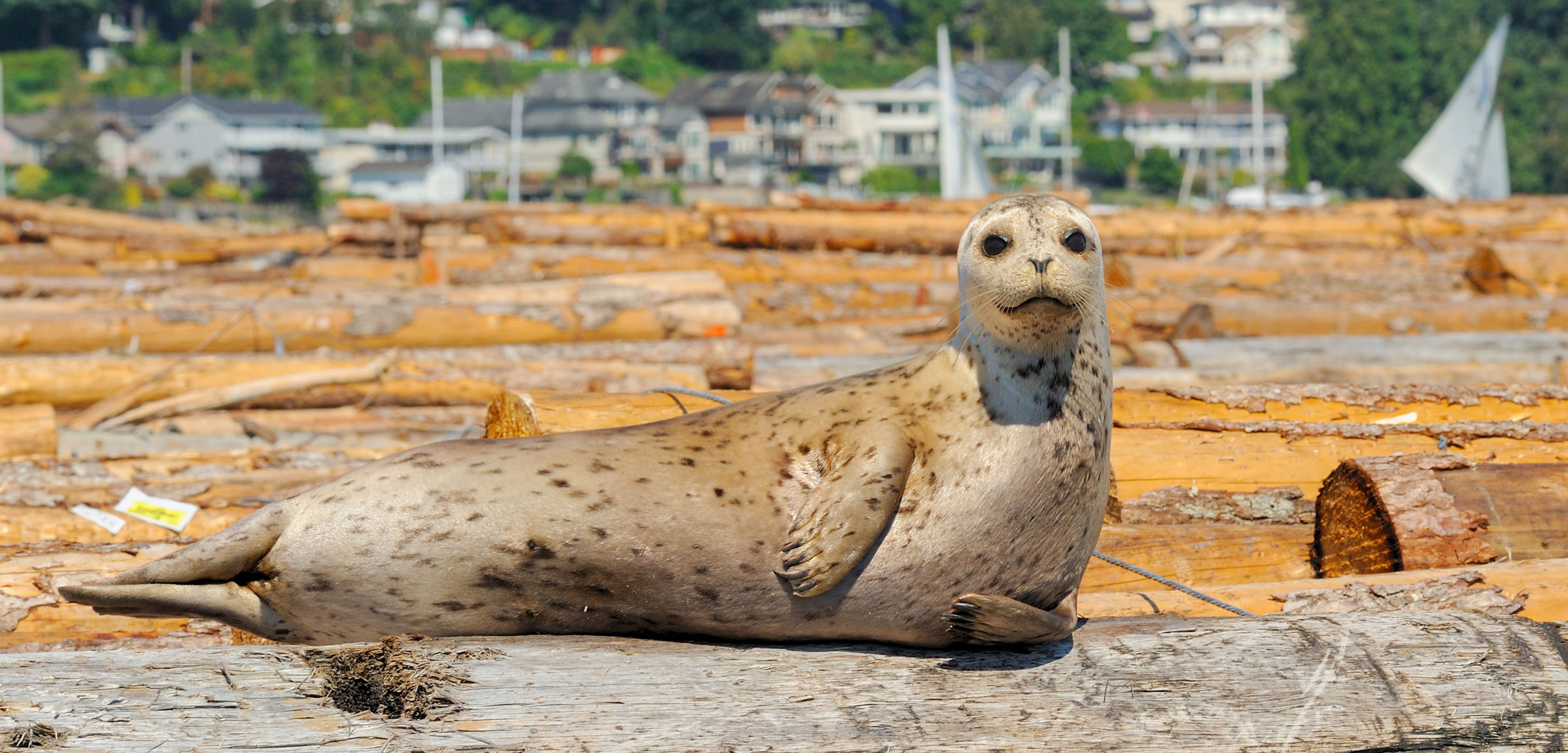The Estuary Smothered by a Thousand Logs
For decades, scientists have known that allowing the timber industry to store logs in estuaries kills marine life. So why does British Columbia still permit it?
Article body copy
It is almost low tide on a sunny late-July morning in Cowichan Bay, at the mouth of the Cowichan River, on southeastern Vancouver Island. I walk alone across the exposed tidal flats of the estuary, wading through brackish streams, skidding on mud, and sidestepping barnacle-crusted rocks. Sounds of clanging and grinding drift from the Western Forest Products lumber mill on shore, mixed with the cries of gulls and bald eagles.
But there’s another sound, too—plaintive, not unlike a human baby’s cry.
The sound emanates from an implausible location: inside a rectangular industrial log boom about the length of a football field. The boom consists of a perimeter of outer logs chained together to protect an inner cargo—typically, bundles of western hemlock, Douglas fir, and western red cedar logs. A tugboat hauled the boom here from a logging operation up the coast so that its contents can be processed at the mill.
From a distance, the log boom presents a familiar, almost nostalgic image of British Columbia’s working coast. Up close, it is an intimidating, two-to-three-meter-high tangle of dead trees resting upon the dark ooze.
I follow the cries until I locate a dappled, dark-gray harbor seal pup, belly-deep in water, trapped in an open pocket inside the boom. Hearing the splash of my neoprene booties, it looks back and forth—likely for its mother—then retreats deeper into the logs, then comes out again.
A young harbor seal trapped inside a log boom at low tide cries for its mother, who has left temporarily for deeper water. Video by Larry Pynn
Seals often seek out log booms for haulouts and to give birth and raise their pups. Because booms float atop the water, they don’t submerge at high tide as offshore rocks often do. They also offer protection from land predators such as wolves, cougars, and bears. In some ways, “you couldn’t ask for a better maternity ward than a log boom,” says Andrew Trites, director of the Marine Mammal Research Unit at the University of British Columbia (UBC).
The problem is, these platforms can also kill. In places like Cowichan Bay, booms sink onto the seafloor at low tide. Before they do, mother seals escape to deeper water, but newborn pups they leave behind can be crushed by shifting logs. No researcher has officially studied the issue, but a local resident has captured dozens of gruesome photos of pups that died this way in Cowichan Bay over the last decade. On my visit, I see several vultures perched on the boom and atop nearby wood pilings, as if they sense the possibility of this particular pup’s demise.
Log booms threaten more than just seal pups. If anchored near the mouths of salmon-spawning streams, booms offer a convenient platform for hungry seals, putting the fish at greater risk of being chomped. “They get to sleep next to their grocery stores without having to travel far,” Trites says. Booms that ground out at low tide can also destroy important habitat and marine life, including seaweeds, eelgrass, fish eggs, shellfish, and more.
The Cowichan River estuary is one of the largest and most important in British Columbia. The watershed drains 90,000 hectares and provides critical habitat to dozens of fish species, including steelhead, chinook, chum, coho, and pink salmon, as well as brown, cutthroat, and rainbow trout. But the Cowichan’s troubles are by no means unique; they are a case study for a much larger problem. Timber companies store log booms all along the BC coast, says Jamieson Atkinson, a fish biologist and program manager for the Aquatic Research and Restoration Centre at the British Columbia Conservation Foundation (BCCF). “It’s shocking.” And while estuaries make up less than three percent of British Columbia’s coast, they provide rich habitat for 80 percent of the province’s coastal wildlife. The Fraser River estuary, near Vancouver on the BC mainland, supports more than 300 species of birds and 80 species of fish and shellfish for at least part of their life cycles.
Placing log booms in deeper water helps to reduce the environmental impacts of grounding out at low tide. Video by Larry Pynn
The fact is, log booms in estuaries are a leading cause of estuary degradation, says Atkinson, who is studying salmon and seals in Cowichan Bay. “It’s like this cascading impact on every aspect of the ecosystem.”
The warning signs of log booms’ impacts have been around for at least half a century. In 1973, the US Environmental Protection Agency released a report that identified bark from booms as one major impact. When bark sinks and deteriorates on the ocean floor, it consumes oxygen and leaches chemicals that can harm fish and other aquatic life. The report—based on three years of research in Oregon, Washington, and Alaska—called on industry to “strive to improve” its practices.
In 2003, the forest industry and the Canadian federal and BC provincial governments also identified bark as a major problem, in a guidebook developed for log-handling facilities. Bark can smother bottom-dwelling invertebrates critical to the marine food chain, the book notes, as well as release sulfides, methane, and ammonia that are toxic to some creatures. Particulates such as silt and fine bark debris can make the water murky, threatening fish gills and respiration. Shading from the booms can reduce plant growth by blocking sunlight. Industry and government reached a firm consensus: “No facilities should be developed on or adjacent to extensive tidal flats, salt marshes, kelp or eelgrass beds, seaweed-harvest areas or shellfish beds,” the guidebook recommends. “Logs should not be dumped or stored in areas where they will ground at low tide.”
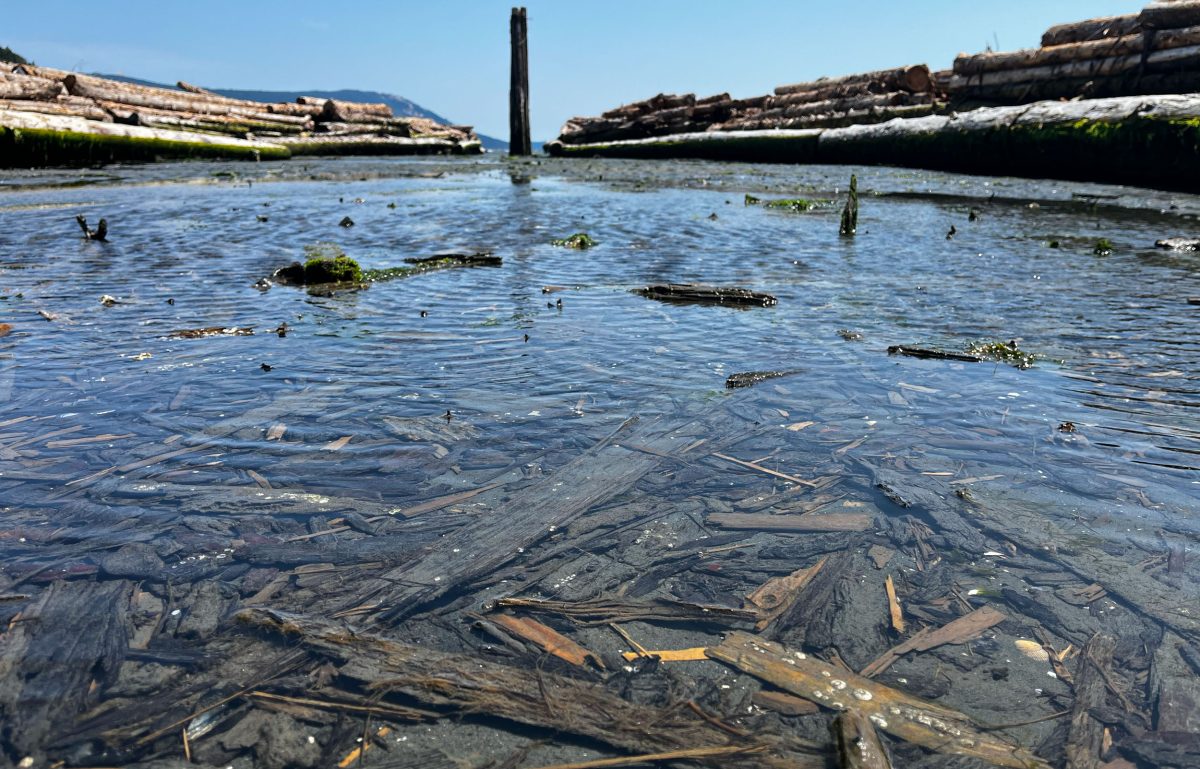
Log booms shed bark that can smother bottom-dwelling invertebrates and leach chemicals toxic to some marine life. Photo by Larry Pynn
Yet grounding out is exactly what continues to happen in Cowichan Bay and other coastal areas, including the lower Fraser River. Noah Kussin-Bordo, fisheries manager with the First Nations Fisheries Council of British Columbia, found during research for his master’s degree at UBC that log booms lined 29 percent of 153 kilometers of shoreline surveyed in the lower Fraser River—and a high of 51 percent in one 13-kilometer stretch. Most of those sites had reduced vegetation cover and compacted sediments, likely from grounding, as well as significantly fewer benthic invertebrates than sites without booms, which boasted more than four times more of those critters. Kussin-Bordo concluded in his 2022 thesis that allowing log booms to ground is in “direct contradiction with known best management practices for log storage.”
In southeast Alaska, the state requires companies to keep their logs off the ocean floor, says Tyler Gunn, timber sale program manager in the Tongass National Forest. Timber companies working there now mostly use barges with ramps to transport logs from remote areas. But where companies still use booms, there must be a minimum of 12 meters of water clearance to ensure stored logs don’t run aground. “It’s to protect anything underneath there,” Gunn says. “You’re going to have plants, crabs, snails, all sorts of other marine animals down there, and you don’t want to affect them at all.”
Fisheries and Oceans Canada (DFO) does have guidelines for helicopter log-drop sites on the BC coast that suggest a minimum of 30 meters of water depth, reduced to 20 meters for short-term log storage, to protect “important habitat” for marine life. But the booms remain.
Alexandra Coutts, communications adviser for DFO, said in a written statement that the agency recognizes that tidal log booming and storage sites such as Cowichan Bay and the lower Fraser River are not ideal. She adds that relocating those facilities might just spread impacts over a broader area. “Grounding at these historically impacted sites with existing wood debris deposition is of much lower risk of additional impacts to fish habitat compared to the creation of a new log storage site.” But there is some evidence that boom sites can be rehabilitated: numerous projects of this sort have proven successful at similar locations on the southern BC coast.
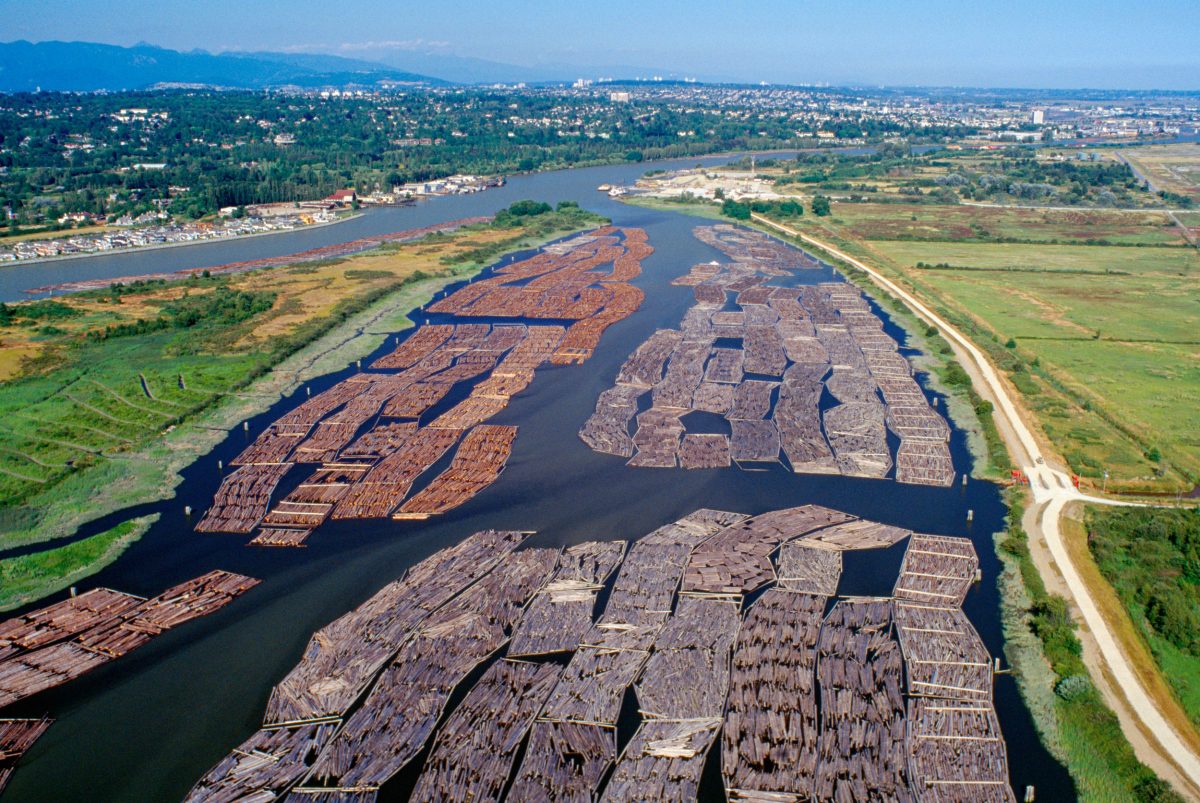
A study of log-boom sites in the lower Fraser River found reduced vegetation cover and compacted sediments, likely from grounding, as well as significantly fewer benthic invertebrates. Photo by Gunter Marx/SW/Alamy Stock Photo
Logging companies have financial and practical reasons for storing logs in estuaries. According to a 2015 cost-benefit analysis commissioned by Western Forest Products (WFP), estuaries generally provide calmer waters and lower salinity, resulting in reduced damage from shipworms, a wood-boring saltwater clam also known as teredo. Moving WFP’s Cowichan Bay booms 380 meters into deeper waters would cost $669,917 for new tie-ups, including steel piles, buoys, anchors, and support wires, the report notes. It would increase the towing distance to the mill, with the “substantial risk” of losing logs due to prevailing southeasterly winter winds. The resulting increase in operating costs from all of that would amount to about $542,000 per year.
WFP’s provincial license of occupation for boom sites within the bay is up for renewal in 2027. “There are a number of factors including safety and marine traffic navigational considerations that determine the location of log storage grounds,” says Babita Khunkhun, the company’s senior director of communications. “Any decision to move them would need to involve the appropriate agencies.”
How decision-makers will weigh economic and safety considerations against booms’ environmental impacts in Cowichan Bay remains to be seen. When it comes to the seals, at least, DFO shows little concern for squished pups. “In the wild, natural mortality on haulouts can be quite high, examples being from predatory birds, starvation, or storms that sweep pups into the water,” the department said in an email.
But UBC’s Andrew Trites points out that harbor seals play an important role in the recovery of threatened transient, or Bigg’s, killer whales on Canada’s Pacific coast. “Some people will say we don’t need any more seals, but I could introduce you to 350 killer whales that will disagree and see every seal as a dinner,” Trites says. “All of us have a responsibility in some way to minimize harm if there is an obvious way to do that.” Commercial whale watchers report killer whales increasingly targeting log booms in their search for seals. “They’d just need the tip of a seal’s flipper to be dangling over the edge to be able to grab one,” says Erin Gless, executive director of the Pacific Whale Watch Association. “Or, the whales simply lurk there quietly until a seal lets its guard down and decides to go for a dip.” It’s also possible whales might try to flush young seals off the booms. Veteran whale watching guide Mark Malleson has observed two killer whales use their “pressure wave” to successfully hunt a seal pup on a rock in the Chain Islets off Victoria, British Columbia. “The first one washed it off and second one grabbed it.”
In Cowichan Bay, there is an obvious way forward, says Atkinson, the BCCF fish biologist. Situating the booms out in deeper water, such as where oceangoing ships already anchor, he argues, will have benefits that extend well beyond seal pups and the estuary floor.
To find out more, I join Atkinson one July morning for an excursion out to the mouth of the Cowichan River aboard a 5.5-meter welded-aluminum power boat. He closely monitors the depth sounder and nudges the vessel alongside one of the Cowichan log booms. Since the summer of 2017, he has led the Cowichan Tribes study on how booms like this one impact seal predation on chinook salmon in this estuary. Adult chinook typically arrive from mid-August to early October—after the seal-pupping season—to migrate up the Cowichan River to spawn. But when flows are low due to drought, the salmon are forced to linger off the river mouth until heavy rains arrive. This can prolong their contact with seals that are congregating on the floating booms in the same area. The seals “just have a feast,” says Atkinson.
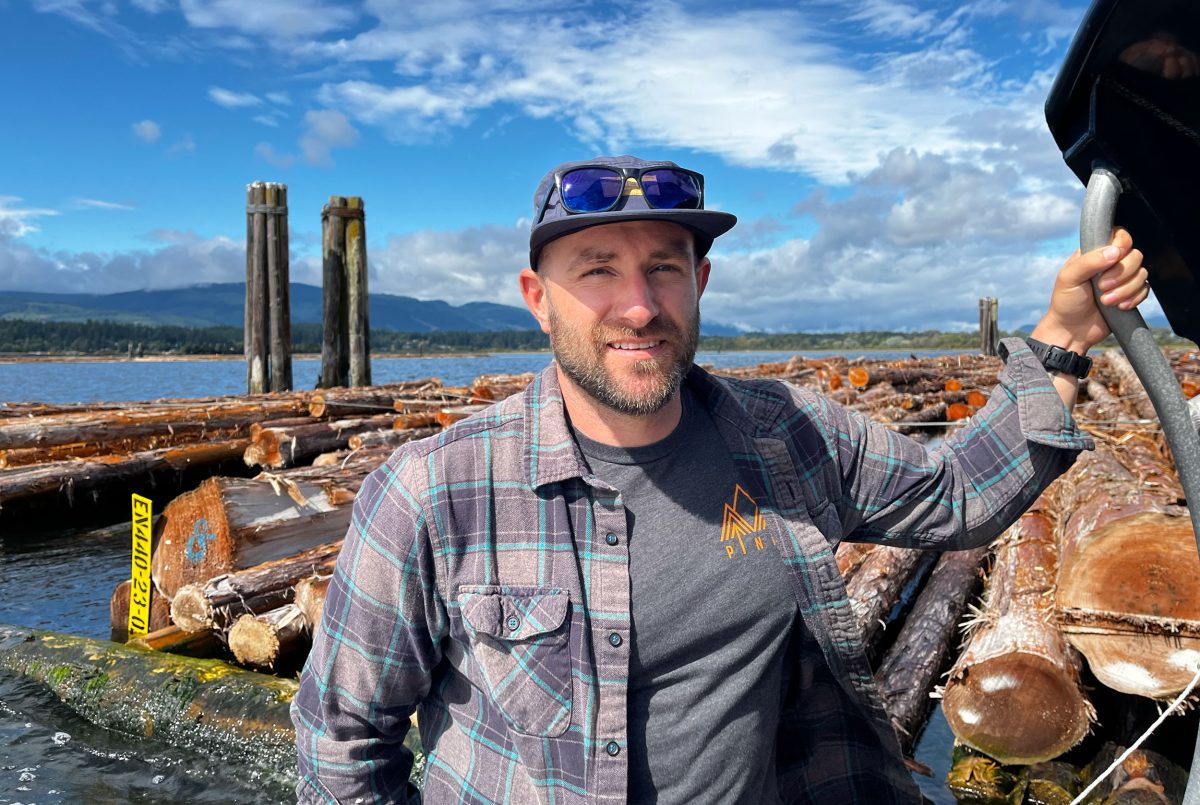
Jamieson Atkinson, a biologist with the British Columbia Conservation Foundation, is studying the impact of harbor seals and log booms on chinook salmon that return to the Cowichan River. Photo by Larry Pynn
In the pilot year of the study, when water was unusually low, Cowichan Tribes and the BCCF used passive integrated transponder (PIT) tags to track adult chinook. Only 36 percent of tagged fish made it beyond the lower river. “That was significantly lower than any of us thought,” Atkinson says. So they partnered with the University of Victoria, with funding from the Pacific Salmon Foundation and the British Columbia government, for a multiyear project. The researchers deployed acoustic tags in addition to PIT tags to better understand salmon movements, including their depth and acceleration—factors indicating an attempt to escape from predatory seals. A labor strike at the WFP mill in 2019 provided a handy control scenario since booms were not present in the bay during that year’s fieldwork.
Study results show that river levels are the primary driver of chinook success in making their way upriver to spawn, but the presence of log booms has a statistically significant impact, according to a report released in June 2024 based on six years of data.
During periods of high river flows, 100 percent of tagged fish survived when booms were absent, but when booms were present, only 63 percent of fish survived. During average flows, no booms in the estuary meant 90 percent of fish, compared with 57 percent when booms remained in the estuary. And during low flows, those numbers cratered, to 57 percent without booms and just 24 percent with booms. “It paints a pretty good picture,” Atkinson says. “The reality is, the log booms have to be out of the estuary.”
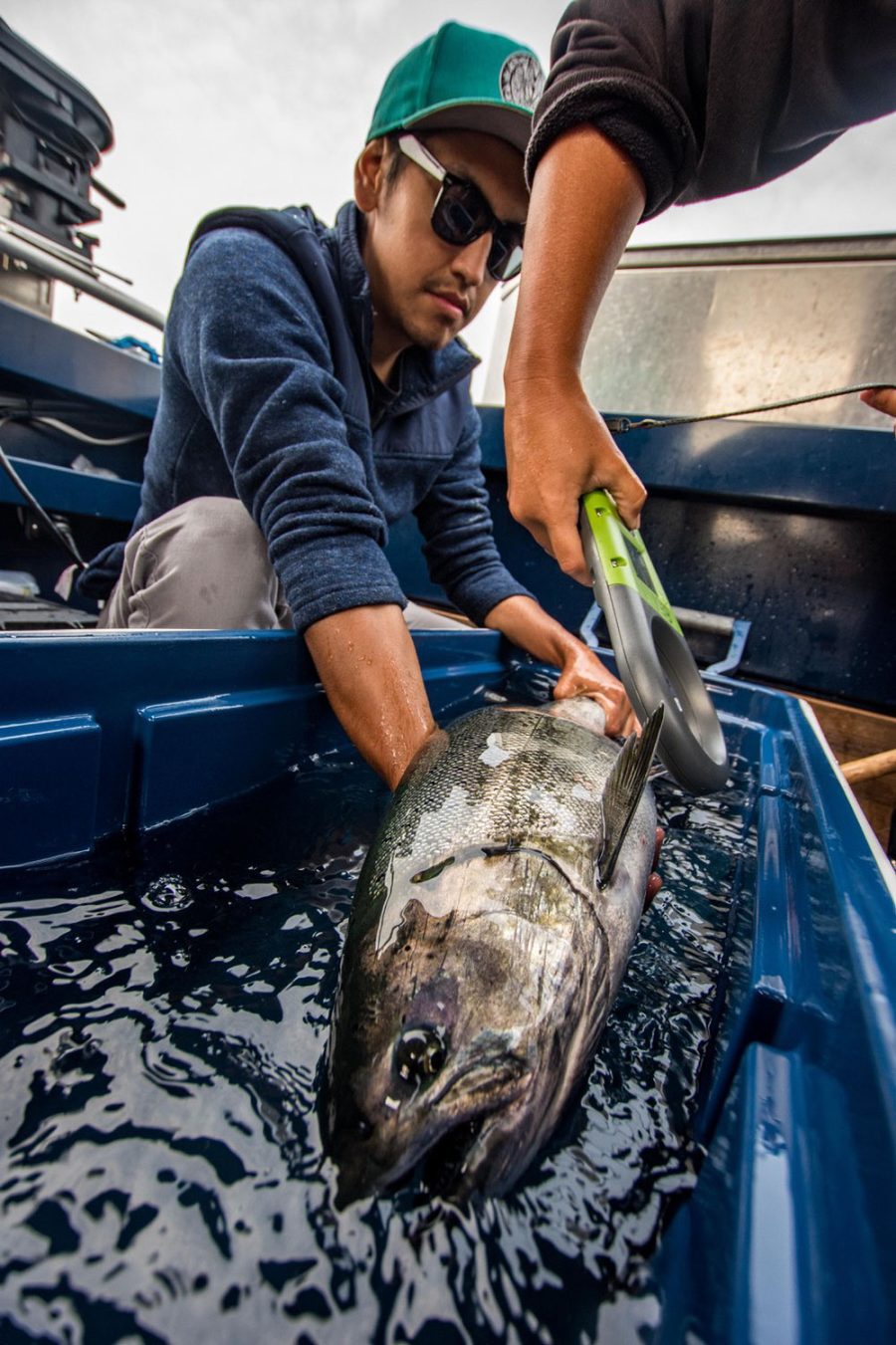
Cowichan Tribes is participating in a study to tag chinook salmon and monitor their survival while migrating up the Cowichan River to spawn. Photo by Danny Swainson
If WFP moved its log booms into deeper water, along with the boom boats whose propellers stir up the surrounding seafloor, it would also open new opportunities to restore the estuary by transplanting eelgrass into damaged sites.
Transplants are already showing success at other former boom sites in Genoa Bay, off Cowichan Bay. Adding yet more eelgrass “would really benefit the salmon migration in and out of the river system,” says Nikki Wright, former executive director of the SeaChange Marine Conservation Society.
Much of the local community is aligning in support of the marine ecology and how it stands to benefit from a change. The Municipality of North Cowichan adopted an Official Community Plan in 2022 that urges “phasing out of intertidal log boom storage in the Cowichan estuary in favor of deepwater storage or dry land log sorts.”
Conservation groups are also showing strong support. “The ecological benefits by far outweigh the additional cost for deepwater storage,” says Goetz Schuerholz, chair of the Cowichan Estuary Restoration and Conservation Association. Estuary advocates plan to marshal as much research as possible for WFP’s license renewal process in 2027. “We’re gearing up for a battle,” Atkinson says.
Two days after I find the crying seal pup trapped inside the log boom in Cowichan Bay, I return to the place in a sea kayak on an afternoon flood tide. Mount Tzouhalem shadows the boat and waves splash the gunwale.
About 100 meters from the boom, I once again hear a baby seal’s voice, hurried to me on a brisk, southeasterly wind. I squint against the sun and spot an adult seal hauled out on a perimeter log at the corner of the boom, which is now fully afloat. Then I spot the young seal just beyond the mother’s bulk.
Pups typically cry when trying to locate their mothers or when stressed or hungry, according to Trites. Perhaps the adult seal in this case is not its mother after all, or maybe the pup is just saying, “More milk, please.”
I linger a few minutes more, then start my way back. There is no way of knowing whether it’s the same pup I found stuck in the boom. But the absence of vultures suggests that for this day—or this tidal change, at least—death lingers elsewhere.

